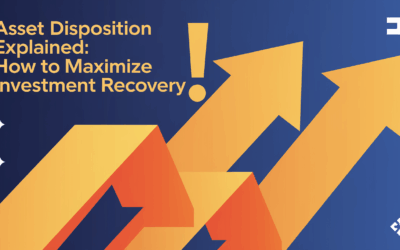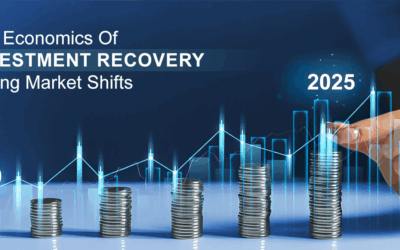Maximizing Returns Through Effective Surplus Asset Recovery Strategies
As the business landscape continues to be dynamic and increasingly competitive, effective management of surplus assets is becoming crucial in maximizing returns and optimizing resources. Whether freeing more space for the workplace, getting rid of excess inventory, or recovering funds from purchased assets, investment or asset recovery can make a positive impact on your bottom line. So, when you plan effective surplus asset recovery strategies, you are not only cutting costs but also playing a key role in sustainability and environmental benefits.
Therefore, to get you started, we have compiled effective surplus asset recovery strategies for maximizing returns.
What You Need to Know About Asset Recovery
Investment recovery is the process of recouping the value invested in redundant or surplus assets. Whether it is physical assets like machinery, real estate, and equipment, or intangible assets including financial investments, licenses, or patents (intellectual property), effective management of these surplus assets benefits businesses in numerous ways.
By establishing an asset or investment recovery strategy, you can convert assets that are no longer essential for business operations into liquid funds. This can be accomplished through the following:
- Redeployment
- Recondition/refurbishment
- Resale—private treaty sale, auction, sealed bid, consignment, and fixed-price sale
- Donation
- Disposal
Businesses, whether large or small, practice asset recovery of varying degrees.
How Can Surplus Asset Recovery Strategies Benefit Your Business
To understand why asset recovery is crucial for your business, it is important to know the vast array of benefits it offers.
Recovering Capital
An investment recovery strategy primarily aims to recoup your capital. Liquidating these unused assets not only enhances cash flow but also gives you the flexibility to redirect the recovered funds to meet your business’s current growth requirements.
Reducing Inventory
If you have slow-moving or stagnant inventory, you should definitely consider implementing asset recovery strategies. Through investment recovery, businesses can regain value and clear storage space, allowing for more efficient inventory management that focuses on essential assets.
Creating More Space
Holding onto surplus assets in warehouses or buildings often leads to hefty storage costs. By liquidating these idle industrial assets, you can free up valuable space for better economic or business purposes.
Mitigating Risk
Asset recovery also plays a key role in reducing financial risks from theft, fraud, or mismanagement. Wondering how? When companies utilize robust asset recovery strategies and systems, they are better equipped to identify and proactively manage risks, and track, manage, and account for these assets properly. For instance, using asset tracking technology helps monitor high-value assets, lowering the risk of loss or theft.
Supporting Sustainability
Sustainability is no longer a buzzword but a growth imperative and competitive advantage. For investors, a commitment to sustainability makes a business more attractive for future investments. For the company itself, meeting sustainability objectives can help avoid expensive setbacks and improve brand reputation.
Gaining Environmental Benefits
When you repurpose or resell surplus items, you are essentially preventing piling up in scrap yards or landfills. Asset recovery, thus, not only addresses environmental concerns but also helps in building your reputation as a socially and environmentally conscious business.
Effective Surplus Asset Recovery Strategies for Maximizing Returns
Let us delve into effective investment recovery strategies that can have a real impact on your asset recovery efforts.
Leverage Technology for Asset Recovery
Companies are increasingly adopting advanced asset tracking systems and data analytics tools. Technologies such as RFID tags, GPS, and cloud-based platforms enable monitoring and analyzing asset usage and performance in real-time. Moreover, by leveraging data analytics, you can gain insight into usage patterns, and forecast future asset requirements. This data-driven approach can enable you to make informed decisions on whether to redeploy, sell, or dispose of your assets.
Ensure Effective Asset Lifecycle Management
Effective lifecycle management of assets can help in identifying surplus assets at the right time by understanding each asset’s life cycle, from acquisition to disposal. When companies implement regular maintenance schedules and performance evaluations, they are better informed about extending the lifespan of assets and maintaining their value. By understanding the depreciation and residual value of assets, you can decide the right time to recover assets, thus maximizing returns and minimizing losses.
Develop a Robust Asset Redeployment Program
Replying assets within the organization, many times may prove more cost-effective than buying a new one. To facilitate effective redeployment, you can consider developing a robust redeployment program that includes a platform or an internal marketplace where departments can list or request surplus assets. Such programs also encourage the reuse of assets across different departments or functions, resulting in cost savings and resource utilization.
Engage in Strategic Asset Divestment
Divestment efforts usually involve selling surplus assets in a way that aligns with both business objectives and market trends. However, this requires a deep understanding of the market demand, potential buyers, and the right timing for asset sales. Companies can consider various channels for divestment, including online auctions, direct sales to other businesses, or partnering with third-party resellers. A strategic asset divestment plan, thus not only generates immediate revenue but also optimizes your asset portfolio for future growth.
Consider Sustainability in Asset Disposal
Sustainability should become the mainstay of surplus asset recovery strategies. Businesses should dispose of assets in an environmentally responsible manner, aligning with the principles of the circular economy. Options such as recycling, refurbishing, or donating assets to extend their lifecycle and reduce environmental impact should also be considered. Incorporating sustainability in your asset disposal plan not only promotes adherence to regulatory compliance but also has a positive impact on brand image.
Partner with Asset Recovery Specialists
When companies lack internal resources or expertise, partnering with asset recovery specialists can be beneficial. These specialists are adept at understanding the complexities of the asset recovery process, conducting deep market research, and negotiating better deals. Organizations can enhance their asset recovery initiatives and reduce potential risks associated with the disposal of assets by engaging with such professionals.
Final Words
If you are looking at maximizing returns and optimizing resource allocation, then it is high time to focus on your surplus asset recovery strategies. By leveraging technology, adopting a proactive asset management approach, and following best practices in asset recovery, companies can improve operational efficiency as well as their bottom line. If implemented correctly, these strategies not only contribute to immediate financial gains but also support long-term sustainability and growth.



